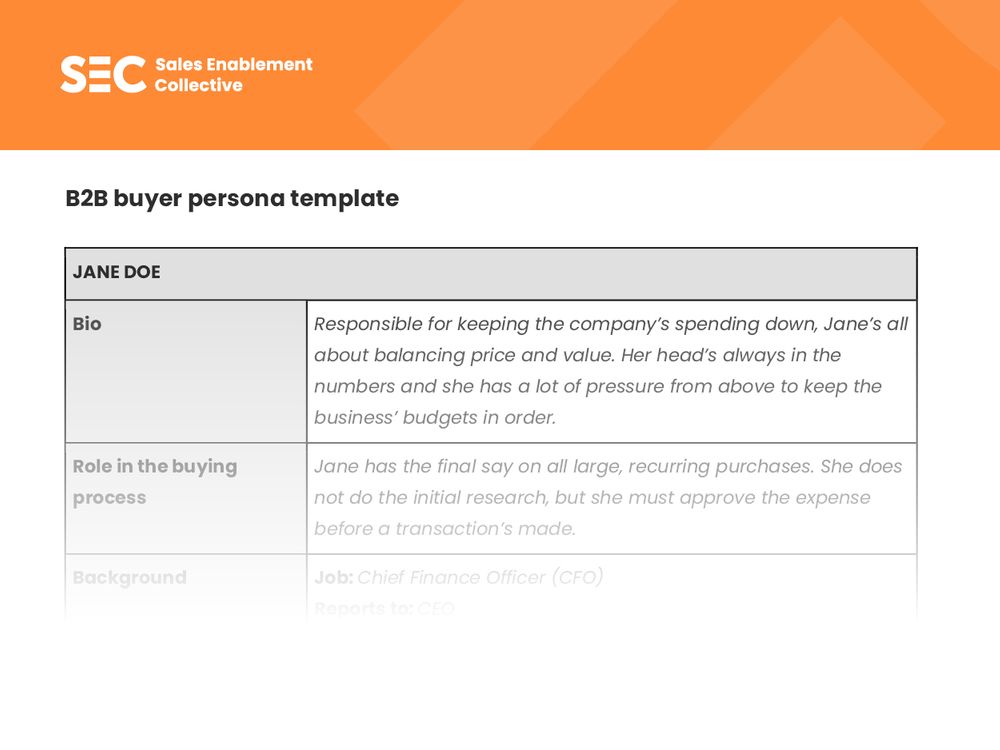Broadly and briefly speaking, a persona is a fictional character that represents real market segments of a customer base.
However, there are two very different categories of personas and it’s imperative to really understand the distinction between them and how they will prove most useful to your sales enablement strategies.
So, let’s start by introducing you to two very important fictional people: buyer personas and user personas.
To fully understand these two characters, you first need to untangle the difference between a buyer and a user.
A buyer is someone who makes a purchase.
A user is someone who uses or operates something.
So, Dave bought an iPhone last week. Dave is the buyer. He acknowledged the need for a new smartphone because his old one was cracked and the battery life wouldn't last a day. And, he now uses his brand spanking new phone daily. It has to satisfy his user problems, look sleek and offer great performance. So, Dave is also the user.
In B2C, your buyer persona and your user persona will often be the same character. We can link two roles in the same persona, which does make it a little easier for most B2C companies to create that one persona who represents the person that’s exposed to their product from beginning to end.
However, for B2B companies, there’s a little more to unpack. Let’s categorize the two personas in full:
What are buyer personas?
Here, we have Josh. He is a buyer persona. A start up owner, he has bought new software for his team to improve their email deliverability. It’s important to note that he doesn’t actually do sales emails, but just leads the team that will be.
The type of person that actually buys a product can vary dramatically. In reality, that makes pinpointing a specific buyer persona a very difficult challenge.
- It could be a member on a team of decision makers who decide whether to purchase something or not. This group will want to know whether your product will boost their team’s productivity.
- It could be staff in the financial department; they will want to see a clear economic benefit to your product.
- It could be someone in the executive team. These guys will need to know how your product is going to benefit their high level goals.
According to the Harvard Business Review, there are actually 6.8 people involved in the B2B purchasing process - that’s a lot of different characters to keep in mind during the stages of product development and marketing where personas are often used. Each one has a different motive, a different goal and possibly, a different preferred type of product.
As a result, a B2B company will often have to create several buyer personas in order to fully address the expectations of varying buyers and there’s no point in us sugar coating it, this isn't an easy task to keep track of.
(Pssst. Head over to our membership plans to access B2B and B2C buyer and user persona templates, and a bunch of other customizable sales enablement templates, like objection handling scripts, customer journey maps, sales one-pagers and more👇 )

Creating buyer personas
For the most effective buyer persona, ensure you address all the issues and aspects that may have an impact on how, when, and why the person will buy. These may include
- Demographic information,
- Patterns of behaviour
- Motivations
- Goals
- Barriers
- Spending capacity
- Communication preferences
It’s a lot of factors to take into account, we know. But we promise it’ll all be worth it when you get that easy insight during product development into what your different buyers really want from your products - and for your reps to tap into when pitching.
What are user personas?
A user persona is that person on Josh’s team who’ll be using the email deliverability product. It isn't necessarily someone who buys from you. They may not even like your product (sorry!), but will have to use it because their management insists. Or, on the flip side, it could be something they really want, but their manager, or the person in charge of spending, does not, so they have to convince them why they should buy.
What the user persona wants from a product is often simple: they want clarity of use and navigation. They really just want an easy and enjoyable ride and most importantly, for the product to do what it says on the tin.
Creating user personas
When creating user personas, you can use the above bullets that make up the buyer persona as a rough guide, but also try to notice what really differentiates a buyer and a user of your product. Solid research is imperative at this point.
Top tip: when creating user personas, it’s important to pay attention to their skills (what technology they use as well as their previous experience).
Knowing the difference between these two types of personas is crucial. It enables the creation of a good persona over a duff one. Your job and the job of personas isn’t just to help reps to sell, it’s to drive adoption and usage. Otherwise, you might be hitting the sales targets, but you’ll also have a lot of churn.
Creating and using personas wisely and understanding the nuances between user and buyer will permeate your product launching process and provide the perfect platform from which to position your product and set your reps up for sales success.
Want more good stuff like this ☝️ ?
To get your hands on more exclusive content and resources (including lifetime access to ALL of the presentations from our events) sign up for SEC membership.



